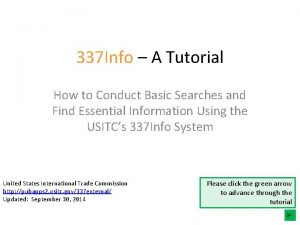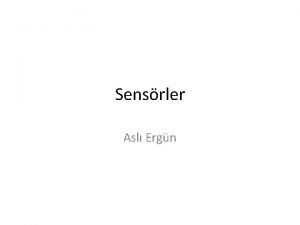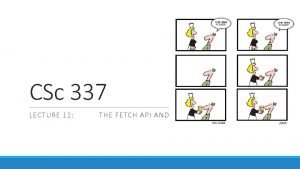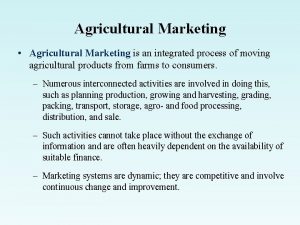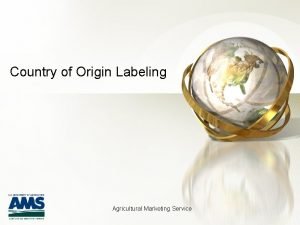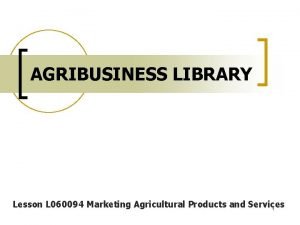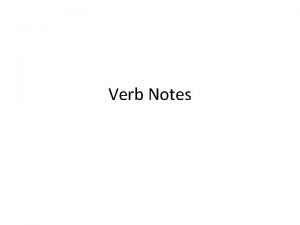ECON 337 Agricultural Marketing Chad Hart Associate Professor





















- Slides: 21

ECON 337: Agricultural Marketing Chad Hart Associate Professor chart@iastate. edu 515 -294 -9911

Short Hedgers Ø Producers with a commodity to sell at some point in the future ØAre hurt by a price decline Ø Sell the futures contract initially Ø Buy the futures contract (offset) when they sell the physical commodity

Short Hedge Example Ø A soybean producer will have 25, 000 bushels to sell in November Ø The short hedge is to protect the producer from falling prices between now and November Ø Since the farmer is producing the soybeans, they are considered long in soybeans

Short Hedge Example Ø To create an equal and opposite position, the producer would sell 5 November soybean futures contracts Ø Each contract is for 5, 000 bushels Ø The farmer would short the futures, opposite their long from production Ø As prices increase (decline), the futures position loses (gains) value

Short Hedge Expected Price Ø Expected price = Futures prices when I place the hedge + Expected basis at delivery – Broker commission

Short Hedge Example Ø As of Jan. 20, Nov. 2017 soybean futures Historical basis for Nov. 0. 30 Rough commission on trade Expected price ($ per bushel) $10. 29 $$-0. 01 $ 9. 98 Ø Come November, the producer is ready to sell soybeans Ø Prices could be higher or lower Ø Basis could be narrower or wider than the historical average

Prices Went Up, Hist. Basis Ø In November, buy back futures at $11. 50 per bushel Nov. 2017 soybean futures Actual basis for Nov. Local cash price Net value from futures ($ per bushel) $11. 50 $-0. 30 $11. 20 $-1. 22 ($10. 29 - $11. 50 - $0. 01) Net price $ 9. 98

Prices Went Down, Hist. Basis Ø In November, buy back futures at $7. 00 per bushel Nov. 2017 soybean futures Actual basis for Nov. Local cash price Net value from futures ($ per bushel) $ 7. 00 $-0. 30 $ 6. 70 $ 3. 28 ($10. 29 - $7. 00 - $0. 01) Net price $ 9. 98

Short Hedge Graph Hedging Nov. 2017 Soybeans @ $10. 29

Prices Went Down, Basis Change Ø In November, buy back futures at $7. 00 per bushel Nov. 2017 soybean futures Actual basis for Nov. Local cash price Net value from futures ($ per bushel) $ 7. 00 $-0. 10 $ 6. 90 $ 3. 28 ($10. 29 - $7. 00 - $0. 01) Net price Ø Basis narrowed, net price improved $10. 18

Long Hedgers Ø Processors or feeders that plan to buy a commodity in the future ØAre hurt by a price increase Ø Buy the futures initially Ø Sell the futures contract (offset) when they buy the physical commodity

Long Hedge Example Ø An ethanol plant will buy 50, 000 bushels of corn in December Ø The long hedge is to protect the ethanol plant from rising corn prices between now and December Ø Since the plant is using the corn, they are considered short in corn

Long Hedge Example Ø To create an equal and opposite position, the plant manager would buy 10 December corn futures contracts Ø Each contract is for 5, 000 bushels Ø The plant manager would long the futures, opposite their short from usage Ø As prices increase (decline), the futures position gains (loses) value

Long Hedge Expected Price Ø Expected price = Futures prices when I place the hedge + Expected basis at delivery + Broker commission

Long Hedge Example Ø As of Jan. 20, Dec. 2017 corn futures Historical basis for Dec. Rough commission on trade Expected local net price ($ per bushel) $ 3. 96 $ -0. 25 $+0. 01 $ 3. 72 Ø Come December, the plant manager is ready to buy corn to process into ethanol Ø Prices could be higher or lower Ø Basis could be narrower or wider than the historical average

Prices Went Up, Hist. Basis Ø In December, sell back futures at $5. 00 per bushel Dec. 2017 corn futures Actual basis for Dec. Local cash price Less net value from futures -($5. 00 - $3. 96 - $0. 01) Net cost of corn ($ per bushel) $ 5. 00 $-0. 25 $ 4. 75 $-1. 03 $ 3. 72 Ø Futures gained in value, reducing net cost of corn to the plant

Prices Went Down, Hist. Basis Ø In December, sell back futures at $3. 00 per bushel Dec. 2017 corn futures Actual basis for Dec. Local cash price Less net value from futures -($3. 00 - $3. 96 - $0. 01) Net cost of corn ($ per bushel) $ 3. 00 $ -0. 25 $ 2. 75 $+0. 97 $ 3. 72 Ø Futures lost value, increasing net cost of corn

Long Hedge Graph Hedging Dec. 2017 Corn @ $3. 96

Prices Went Down, Basis Change Ø In December, sell back futures at $3. 00 per bushel Dec. 2017 corn futures Actual basis for Dec. Local cash price Less net value from futures -($3. 00 - $3. 96 - $0. 01) Net cost of corn ($ per bushel) $ 3. 00 $ -0. 10 $ 2. 90 $+0. 97 $ 3. 87 Ø Basis narrowed, net cost of corn increased

Hedging Results Ø In a hedge the net price will differ from expected price only by the amount that the actual basis differs from the expected basis. Ø So basis estimation is critical to successful hedging. Ø Narrowing basis, good for short hedgers, bad for long hedgers Ø Widening basis, bad for short hedgers, good for long hedgers

Class web site: http: //www. econ. iastate. edu/~chart/Classes/econ 337/ Spring 2017/ Have a great weekend!
 Promotion from associate professor to professor
Promotion from associate professor to professor Heart to heart merrylands
Heart to heart merrylands 337 form example
337 form example Form 337
Form 337 337 form example
337 form example 337info
337info Esneyebilen bir tabaka üzerine ince bir telin
Esneyebilen bir tabaka üzerine ince bir telin Csc 337
Csc 337 Csc 337
Csc 337 Agricultural marketing process
Agricultural marketing process What is agricultural marketing circle?
What is agricultural marketing circle? Scope of agricultural marketing
Scope of agricultural marketing Marketing mix of agricultural products
Marketing mix of agricultural products Chad b swim helping verbs
Chad b swim helping verbs Vtg gps
Vtg gps Chad vasc score
Chad vasc score Chad ulven
Chad ulven Wiu map
Wiu map Sigmachad
Sigmachad Chad topaz
Chad topaz Hotwash ground rules
Hotwash ground rules Chad posner
Chad posner





